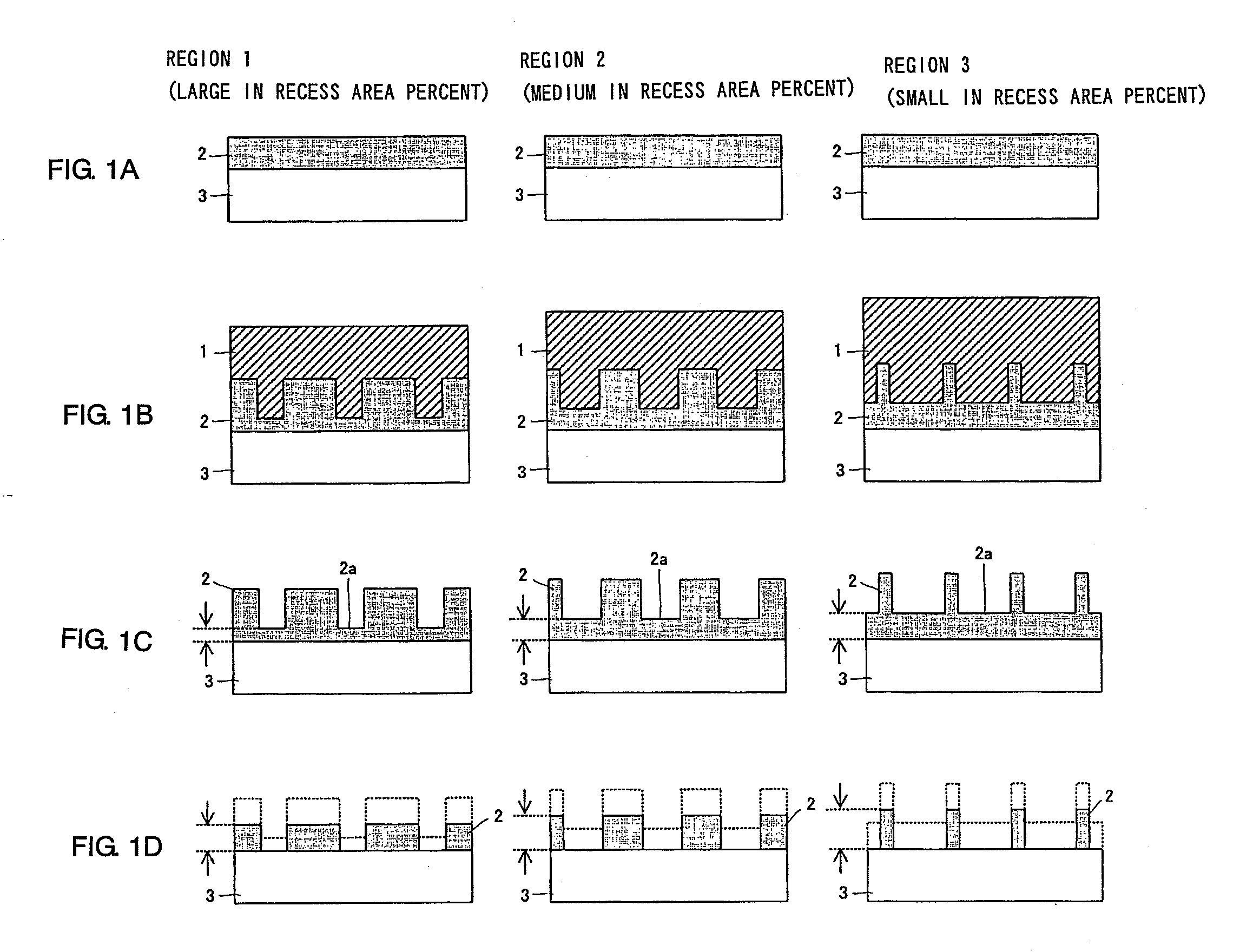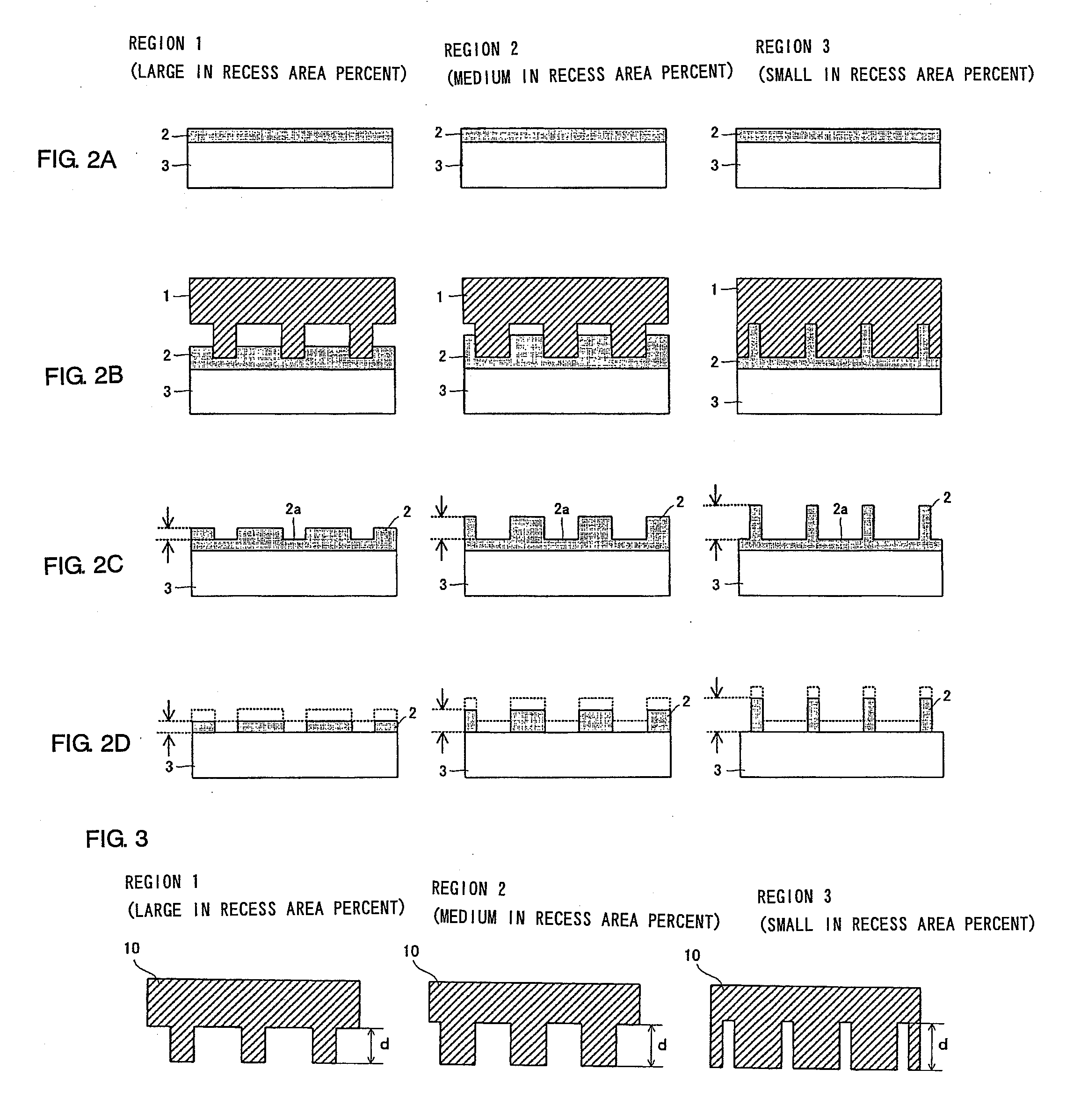Imprinting mold and method of producing imprinting mold
a technology of imprinting mold and imprinting pattern, which is applied in the field of molds, can solve the problems of difficult to form pattern features of 100 nm or less, limited resolution of photolithography, and lack of direct writing by electron beams
- Summary
- Abstract
- Description
- Claims
- Application Information
AI Technical Summary
Benefits of technology
Problems solved by technology
Method used
Image
Examples
embodiment 1
[0046]A first embodiment of the method of producing a mold according to the present invention will be described with reference to FIG. 6. First, a mold substrate forming the base of the mold to be produced is prepared. A substrate 30 made of, e.g., silicon, ceramic, or the like and uniformly coated with an NIL resist 20 as a transfer layer by, e.g., a spin coat method is used as the mold substrate. As the NIL resist 20, light curing resin or thermoplastic resin can be used, and in this embodiment, thermoplastic resin is used. As the thermoplastic resin, for example, polymethyl methacrylate (PMMA) or polystyrene (PS) can be used (FIG. 6 (a)).
[0047]Then, the substrate 30 coated with the NIL resist 20 is heated to about 200° C. to soften the NIL resist 20. Next, a conventional mold 1, where a recess / protrusion surface made up of a plurality of regions different in recess / protrusion area ratio is formed, is put in contact with the softened NIL resist 20, and by applying pressure, the NI...
embodiment 2
[0054]A second embodiment of the method of producing a mold according to the present invention will be described with reference to FIG. 7. First, a mold substrate forming the base of the mold to be produced is prepared. A substrate 30 uniformly coated with an NIL resist 20 as a transfer layer by, e.g., a spin coat method is used as the mold substrate. As the NIL resist 20, light curing resin or thermoplastic resin can be used, and in this embodiment, thermoplastic resin is used. As the thermoplastic resin, for example, polymethyl methacrylate (PMMA) or polystyrene (PS) can be used (FIG. 7 (a)).
[0055]Then, the substrate 30 coated with the NIL resist 20 is heated to about 200° C. to soften the NIL resist 20. Next, a conventional mold 1, where a recess / protrusion surface made up of a plurality of regions different in recess / protrusion area ratio is formed, is put in contact with the softened NIL resist 20, and by applying pressure, the NIL resist 20 is deformed. Then, keeping the mold ...
embodiment 3
[0063]A third embodiment of the method of producing a mold according to the present invention will be described with reference to FIG. 8. First, a mold substrate forming the base of the mold to be produced is prepared. A substrate 30 uniformly coated with an NIL resist 20 as a transfer layer by, e.g., a spin coat method is used as the mold substrate. As the NIL resist 20, light curing resin or thermoplastic resin can be used, and in this embodiment, thermoplastic resin is used. As the thermoplastic resin, for example, polymethyl methacrylate (PMMA) or polystyrene (PS) can be used (FIG. 8 (a)).
[0064]Then, the substrate 30 coated with the NIL resist 20 is heated to about 200° C. to soften the NIL resist 20. Next, a conventional mold 1, where a recess / protrusion surface made up of a plurality of regions different in recess / protrusion area ratio is formed, is put in contact with the softened NIL resist 20, and by applying pressure, the NIL resist 20 is deformed. Then, keeping the mold p...
PUM
| Property | Measurement | Unit |
|---|---|---|
| widths | aaaaa | aaaaa |
| temperature | aaaaa | aaaaa |
| temperature | aaaaa | aaaaa |
Abstract
Description
Claims
Application Information
 Login to View More
Login to View More - R&D
- Intellectual Property
- Life Sciences
- Materials
- Tech Scout
- Unparalleled Data Quality
- Higher Quality Content
- 60% Fewer Hallucinations
Browse by: Latest US Patents, China's latest patents, Technical Efficacy Thesaurus, Application Domain, Technology Topic, Popular Technical Reports.
© 2025 PatSnap. All rights reserved.Legal|Privacy policy|Modern Slavery Act Transparency Statement|Sitemap|About US| Contact US: help@patsnap.com



